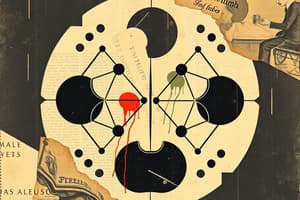Podcast
Questions and Answers
A cell's volume increases at a disproportionately faster rate than its surface area. What challenge does this pose for the cell?
A cell's volume increases at a disproportionately faster rate than its surface area. What challenge does this pose for the cell?
- Its DNA replicates at a slower pace.
- It has difficulty obtaining nutrients and expelling waste. (correct)
- It becomes more efficient at synthesizing proteins.
- It increases the rate of cell division.
Which of the following best describes the primary function of the S phase within the cell cycle?
Which of the following best describes the primary function of the S phase within the cell cycle?
- Division of the cytoplasm.
- Duplication of chromosomes. (correct)
- Cell growth and normal metabolic activities.
- Preparation for mitosis.
During which phase of mitosis do the centromeres split, causing the sister chromatids to move toward opposite poles of the cell?
During which phase of mitosis do the centromeres split, causing the sister chromatids to move toward opposite poles of the cell?
- Telophase
- Anaphase (correct)
- Metaphase
- Prophase
What is the role of the spindle during mitosis?
What is the role of the spindle during mitosis?
During which phase of mitosis do the chromosomes line up along the center of the dividing cell?
During which phase of mitosis do the chromosomes line up along the center of the dividing cell?
Which of the following is the correct organizational hierarchy of living things, from smallest to largest?
Which of the following is the correct organizational hierarchy of living things, from smallest to largest?
What is the role of cyclins in the cell cycle?
What is the role of cyclins in the cell cycle?
What is the process called when the cytoplasm divides?
What is the process called when the cytoplasm divides?
Cancer cells are characterized by uncontrolled growth and division. Which of the following is a primary reason for this behavior?
Cancer cells are characterized by uncontrolled growth and division. Which of the following is a primary reason for this behavior?
A macrophage is a type of cell that provides protection. How does it achieve the function?
A macrophage is a type of cell that provides protection. How does it achieve the function?
Flashcards
Cell Growth Limits
Cell Growth Limits
Cells cannot grow indefinitely due to surface area and volume constraints.
Cell Cycle
Cell Cycle
The interval from one cell division to the next, involving growth and division phases.
Mitosis
Mitosis
The process where a cell divides to form two daughter cells after DNA is replicated.
Interphase
Interphase
Signup and view all the flashcards
Prophase
Prophase
Signup and view all the flashcards
Metaphase
Metaphase
Signup and view all the flashcards
Anaphase
Anaphase
Signup and view all the flashcards
Telophase
Telophase
Signup and view all the flashcards
Cell Specialization
Cell Specialization
Signup and view all the flashcards
Cyclin
Cyclin
Signup and view all the flashcards
Study Notes
Cell Growth and Division
- Cell size is limited; volume increases faster than surface area.
- Larger cells struggle to take in nutrients and remove waste.
- Cell cycle: period from one division to the next.
- Rate varies between cell types, with an average of 20 hours for adult human cells in the cell cycle.
- Multicellular organisms precisely control cell division and growth, which is critical.
- Errors in the cell cycle can lead to diseases like cancer.
- Cell division (mitosis) requires DNA replication before cell division can occur, this happens in the S phase.
The Cell Cycle
- Interphase: period between cell divisions.
- G1 phase: cell growth.
- S phase: DNA replication.
- G2 phase: preparation for mitosis.
- Mitosis: Cell division process.
- Prophase: Chromosomes condense, sister chromatids visible, spindle fibers form.
- Metaphase: Chromosomes align at the cell's center.
- Anaphase: Sister chromatids separate and move to opposite poles.
- Telophase: Chromosomes reach poles, nuclear envelopes reform, cytokinesis begins.
- Cytokinesis: Cytoplasm divides, forming two daughter cells.
Cell Specialization
- Cells specialize to perform specific functions (e.g., nerve, epithelial, muscle, connective tissues).
- Examples include macrophages (immune defense), neurons (communication).
- Organization: Cells → Tissues → Organs → Organ Systems.
- Eleven major organ systems exist in most multicellular organisms.
Controlling the Cell Cycle
- Cyclins: Proteins regulating cell cycle timing.
- Cycling must be made for mitosis, since it gets used up.
- Cancer cells: Uncontrolled cell growth due to defects in cell cycle regulation.
Studying That Suits You
Use AI to generate personalized quizzes and flashcards to suit your learning preferences.
Description
Explore cell growth limits and the importance of controlled cell division in multicellular organisms. The cell cycle, including interphase (G1, S, G2 phases) and mitosis (prophase, metaphase, anaphase), is essential for understanding cell division, and errors can lead to diseases like cancer.




